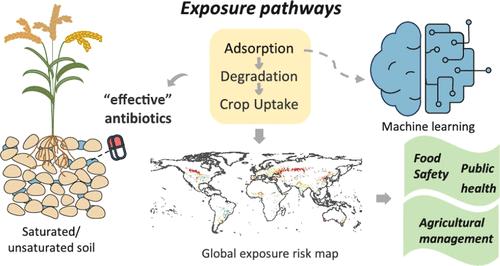当前位置:
X-MOL 学术
›
Environ. Sci. Technol.
›
论文详情
Our official English website, www.x-mol.net, welcomes your
feedback! (Note: you will need to create a separate account there.)
Assessment of Global Antibiotic Exposure Risk for Crops: Incorporating Soil Adsorption via Machine Learning
Environmental Science & Technology ( IF 10.8 ) Pub Date : 2024-07-20 , DOI: 10.1021/acs.est.4c03695 Han Zhu 1 , Jianliang He 1 , Yanmei Wu 1 , Lizhi Tong 2 , Weihua Zhang 3 , Luwen Zhuang 1
Environmental Science & Technology ( IF 10.8 ) Pub Date : 2024-07-20 , DOI: 10.1021/acs.est.4c03695 Han Zhu 1 , Jianliang He 1 , Yanmei Wu 1 , Lizhi Tong 2 , Weihua Zhang 3 , Luwen Zhuang 1
Affiliation

|
The overuse and misuse of antibiotics could significantly increase their accumulation in soils. Consequently, antibiotics possibly enter food chain through crop uptake, posing a threat to global food security. Assessing the exposure risks of antibiotics for crops is crucial for addressing this global issue. In this study, we assessed global antibiotic exposure risk for crops, incorporating a machine learning adsorption model based on 4893 data sets from nine antibiotics. The optimized machine learning adsorption model, using the eXtreme Gradient Boosting algorithm and the class-specific modeling strategy, demonstrated relatively good performance. Notably, we introduced unsaturated soil conditions and considered spatiotemporal variations in soil moisture and temperature for the first time in such a risk assessment. Global distributions of antibiotic exposure risk for crops were predicted for March, June, September, and December. The results indicate that soil moisture significantly influences the exposure risk assessment. Relatively high exposure risk for crops was observed during months with colder local temperatures: generally June for the Southern Hemisphere and December for the Northern Hemisphere. The resulting map highlights high-risk agricultural regions, including southern Canada, western Russia, and southern Australia.
中文翻译:

全球农作物抗生素暴露风险评估:通过机器学习纳入土壤吸附
抗生素的过度使用和滥用会显着增加其在土壤中的积累。因此,抗生素可能通过农作物吸收进入食物链,对全球粮食安全构成威胁。评估农作物的抗生素暴露风险对于解决这一全球性问题至关重要。在这项研究中,我们评估了农作物的全球抗生素暴露风险,结合了基于 9 种抗生素的 4893 个数据集的机器学习吸附模型。优化的机器学习吸附模型,使用eXtreme Gradient Boosting算法和特定类别的建模策略,表现出相对良好的性能。值得注意的是,我们在此类风险评估中首次引入了非饱和土壤条件并考虑了土壤湿度和温度的时空变化。预测了 3 月、6 月、9 月和 12 月农作物抗生素暴露风险的全球分布。结果表明,土壤湿度显着影响暴露风险评估。在当地气温较低的月份中,农作物的暴露风险相对较高:南半球一般为 6 月,北半球一般为 12 月。由此产生的地图突出显示了高风险农业地区,包括加拿大南部、俄罗斯西部和澳大利亚南部。
更新日期:2024-07-20
中文翻译:

全球农作物抗生素暴露风险评估:通过机器学习纳入土壤吸附
抗生素的过度使用和滥用会显着增加其在土壤中的积累。因此,抗生素可能通过农作物吸收进入食物链,对全球粮食安全构成威胁。评估农作物的抗生素暴露风险对于解决这一全球性问题至关重要。在这项研究中,我们评估了农作物的全球抗生素暴露风险,结合了基于 9 种抗生素的 4893 个数据集的机器学习吸附模型。优化的机器学习吸附模型,使用eXtreme Gradient Boosting算法和特定类别的建模策略,表现出相对良好的性能。值得注意的是,我们在此类风险评估中首次引入了非饱和土壤条件并考虑了土壤湿度和温度的时空变化。预测了 3 月、6 月、9 月和 12 月农作物抗生素暴露风险的全球分布。结果表明,土壤湿度显着影响暴露风险评估。在当地气温较低的月份中,农作物的暴露风险相对较高:南半球一般为 6 月,北半球一般为 12 月。由此产生的地图突出显示了高风险农业地区,包括加拿大南部、俄罗斯西部和澳大利亚南部。











































 京公网安备 11010802027423号
京公网安备 11010802027423号